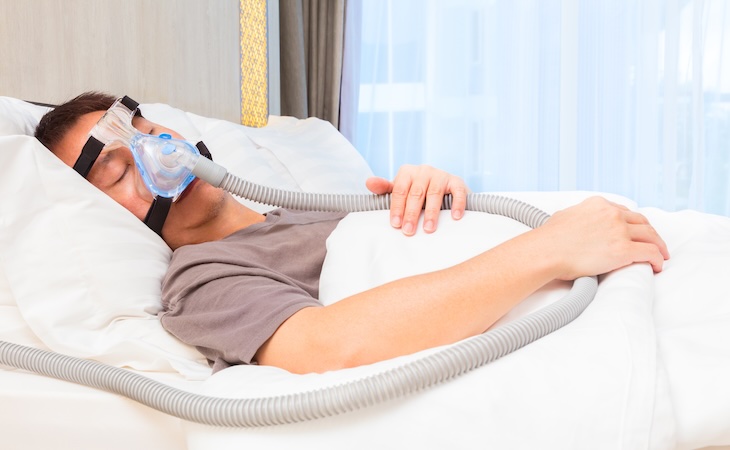Several different disorders can impact sleep. One that can make it extremely challenging to get a good night’s rest is sleep apnea, “a medical disorder characterized by regular pauses in breathing while a person is asleep,” says John Lowe, MD, a physician at Utah-based Restore Care Wellness Clinic with experience in sleep medicine.
Sleep apnea is a fairly common sleep disorder; according to the Cleveland Clinic, it’s estimated that 5%-10% of the population struggles with sleep apnea.
Because it can be so disruptive to sleep, most people with sleep apnea are continually on the lookout for strategies or treatments that can help them improve their sleep apnea and get better sleep.
One of those treatments that’s gained some traction on social media? Mewing. Enthusiasts of this technique claim that the practice offers a host of benefits—including treating the symptoms of sleep apnea.
But what, exactly, is mewing? And can mewing help sleep apnea? Let’s take a look at everything you need to know about mewing and sleep apnea.
What is mewing?
Before we jump into answering, “Does mewing help sleep apnea?” let’s quickly touch on what mewing actually is.
The mewing technique was created by British orthodontist John Mew. It focuses on changing your tongue positioning—and instead of resting your tongue at the bottom of your mouth (as most people do), holding it against the roof of your mouth and applying pressure.
According to Mew, by repositioning the tongue, over time, you can actually restructure your face; the upper jaw expands and teeth push forward—which he claims can change the shape and appearance of your face and jawline.
The mewing technique focuses on changing your tongue positioning—and instead of resting your tongue at the bottom of your mouth (as most people do), holding it against the roof of your mouth and applying pressure.
Many also claim that the jaw changes you can reportedly create through mewing can also provide added health benefits.
In addition to changing the shape of your face, mewing “has become popular because of its purported advantages in…breath control and even sleep-associated issues,” says Lowe. This includes sleep apnea.
Can mewing help sleep apnea?
Now that you know what mewing is, let’s jump into the potential benefits of mewing for sleep apnea.
As mentioned, if you have sleep apnea, you experience regular pauses in breathing while you’re asleep. Because mewing claims to support better breathing, some believe that it could be an effective treatment for sleep apnea.
“Supporters argue that by utilizing all available space within oral tissues, mewing could lead to improved breathing patterns as well as respiratory functions,” says Lowe—which, in turn, could help manage sleep apnea symptoms (like snoring).
The problem is that any evidence for mewing and sleep apnea is anecdotal; while there are certainly people who’ve reported that mewing has helped manage their sleep apnea, there just isn’t the science to back it up.
That being said, there really isn’t any harm in trying mewing (and there could definitely be benefits!)—as long as it’s in tandem with other evidence-based treatments for sleep apnea, like a CPAP machine. (More on that later.)
Any evidence for mewing and sleep apnea is anecdotal; while there are certainly people who’ve reported that mewing has helped manage their sleep apnea, there just isn’t the science to back it up.
Other potential benefits of mewing
In addition to sleep apnea, mewing devotees claim that the practice can help treat a wide variety of aesthetic and health-related issues, including:
- Straightening teeth
- Minimizing teeth crowding
- Treating breathing issues
- Treating sinusitis
- Treating speech issues
- Treating swallowing issues
However, it’s important to note that, just like there isn’t science to support mewing as a treatment for sleep apnea, there isn’t science to back up mewing in general.
While some research links the positioning of the teeth and tongue to jaw development, there’s no direct connection to mewing.
How to try mewing
While there’s no real scientific evidence to support mewing, there’s definitely anecdotal evidence—so if you want to give mewing a try, here’s how to do it:
- Close your mouth, keeping your lips sealed.
- Align your bottom teeth behind your front teeth.
- Place your tongue on the roof of your mouth. (The tongue should be flat against the surface of your upper mouth; you’ll feel your muscles engage.)
- Move the tip right behind your front teeth—like you’re going to make the “n” sound.
- Hold the position for as long as is comfortable (try starting with 10 to 20 seconds).
- Release and repeat multiple times throughout the day.
Again, just make sure that, if you’re going to try mewing for sleep apnea, it’s in conjunction with other proven treatments—and not as an independent or principal treatment for sleep apnea.
Risks of mewing
Is mewing in and of itself a risky practice? Not necessarily. But the real danger comes from people with sleep apnea opting out of other evidence-based treatments in favor of mewing—which can put their health at serious risk.
Alternatives to mewing
If you have sleep apnea, the best thing you can do is talk to your doctor, who can recommend medically proven treatments to help you manage your disorder.
“For individuals diagnosed with sleep apnea, it is crucial to seek appropriate medical intervention,” says Lowe. “Alongside conventional treatments like CPAP or oral appliances, incorporating practices such as maintaining a healthy weight, avoiding alcohol and sedatives before bedtime, and sleeping in a lateral position can also help manage symptoms effectively.”
“For individuals diagnosed with sleep apnea, it is crucial to seek appropriate medical intervention.”
-John Lowe, MD, a physician with experience in sleep medicine
The bottom line on mewing
Does mewing have potential? Maybe; some people claim mewing has helped them reshape their jaw structure and reap a variety of benefits—including improving their sleep apnea treatments.
But is mewing a safe and effective treatment for sleep apnea? There’s not enough evidence to support that claim. “Further studies are needed to determine whether the claims about mewing’s efficacy have any ground and how it affects sleep apnea patients,” says Lowe.
If you’re struggling with sleep apnea, talk to your doctor; they can assess your condition and symptoms and recommend the best evidence-based treatments for you—for example, a CPAP machine.
FAQs
Do tongue exercises really help with sleep apnea?
There’s no scientific evidence that suggests tongue exercises can help with sleep apnea.
Can mewing reduce snoring?
There are anecdotal reports of mewing reducing snoring (as it’s said to reduce mouth breathing and open airways)—but again, there are no studies to support this.
Does mewing block your airway?
No, mewing doesn’t block your airway.
How can I strengthen my tongue for sleep apnea?
There’s no scientific evidence that strengthening or repositioning the tongue is an effective treatment for sleep apnea.
Chin straps are also trending as a potential sleep apnea treatment. Next, learn whether chin straps for sleep apnea work.




